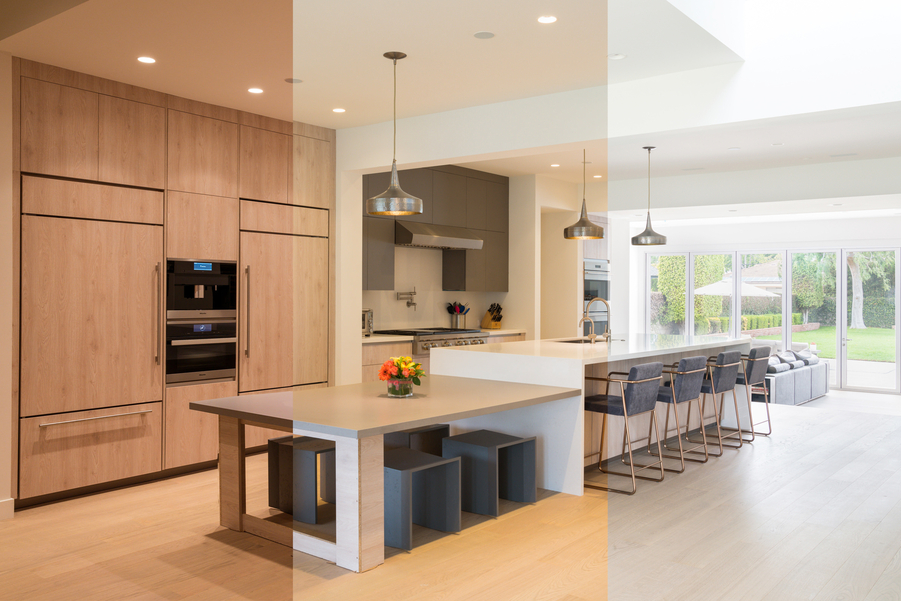Lighting Control Evolution: From Dimmable to Tunable
Learn How Tunable Lighting Moves Beyond Simple Lighting Management

The humble light switch has come a long way. Today's lighting control systems offer homeowners unprecedented flexibility in creating the perfect ambiance for any occasion, any time of day. While most Greenwich homeowners are familiar with traditional dimming capabilities, it’s not unfair to say that tunable lighting technology is revolutionizing how we experience our home environments. Let's illuminate the key distinctions between dimmable and tunable lighting to help you determine which lighting control features best suit your lifestyle.
SEE ALSO: What’s Trending in Lighting Control?
What is Dimmable Lighting?
You intuitively understand what this is, but it’s worth pointing out some differences across technologies. Dimmable lighting is the ability to adjust a light's brightness, allowing you to control the intensity of illumination in a space. The technology behind dimming varies by light source: incandescent bulbs dim smoothly by reducing voltage, while LEDs and fluorescents require specialized dimming modules to prevent flickering or buzzing. Not all bulbs are created equal—traditional fluorescents are notoriously difficult to dim effectively, whereas modern LEDs are designed with dimming capabilities, though they may require compatible dimmers to function properly.
Beyond creating the perfect mood, dimming offers practical benefits: it extends bulb lifespan, reduces energy consumption, and allows for versatile lighting scenes. However, traditional dimming only controls brightness, not the quality or color of light. That's where more advanced lighting control systems come into play.
What is Tunable Lighting?
Tunable lighting takes illumination control a step further by allowing you to adjust not just brightness but also color temperature. Measured in Kelvins (K), color temperature ranges from warm amber tones (2700K) that mimic sunset to cool blue-white light (5000K+) similar to the midday sun. With tunable lighting, you're essentially getting two types of control in one fixture.
One popular option is "warm dim" technology, which allows LED lights to imitate the cozy, amber glow of dimmed incandescent bulbs. Traditional LEDs maintain their color temperature when dimmed, but warm dim LEDs shift to lower, candlelight-like temperatures (around 2200K) as they're dimmed, recreating that familiar, inviting ambiance many homeowners miss from conventional bulbs. More sophisticated tunable lighting systems offer full-spectrum control, allowing you to select from thousands of color temperatures to match your activity, mood, or the time of day—all manageable through your home's lighting control system.
Benefits of Tunable Lighting
You might be surprised to learn that tunable lighting offers wellness benefits by aligning with your body's natural circadian rhythms. Morning exposure to cooler, bluish light can increase alertness and concentration, while warmer tones in the evening signal your body to prepare for rest by promoting melatonin production. Science has shown that this natural light cycle improves sleep quality and overall mood.
The aesthetic advantages are equally compelling. Imagine highlighting artwork with precise lighting temperatures that enhance specific colors and textures, or creating distinct atmospheres for different occasions—from energetic entertainment to intimate dinner settings—all from a single lighting control system.
Practical applications abound throughout your day: cool, invigorating light for morning routines, neutral white light for productive work hours, and gradually warming light as evening approaches, culminating in a gentle amber glow before bedtime.
Integrated Lighting Control Systems
Today's comprehensive lighting control solutions integrate both dimming and tuning capabilities alongside motorized shading for complete light management. These systems allow you to program personalized scenes that combine artificial and natural light for optimal ambiance and energy efficiency.
For example, a "Movie Night" scene might simultaneously dim lights to 20%, shift to a warm color temperature, and lower blackout shades, while a "Wake Up" scene gradually increases brightness and shifts to energizing cool tones while raising sheer window treatments to admit filtered natural light.
While traditional dimming remains valuable, tunable lighting represents the next evolution in home lighting control. Ready to explore how to upgrade your Greenwich home with modern lighting control? Get in touch with us here; we look forward to working with you.



